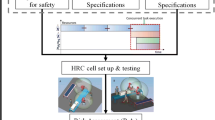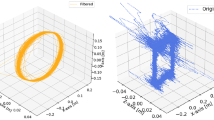Abstract
Research on human–machine collaboration in Industry 5.0 has attracted significant attention in the manufacturing sector. Although human–robot collaboration can improve work efficiency and productivity, the design of its process is time consuming and cost intensive. The digitalization of machines facilitates automation and improves the intelligence of mechanical tasks. However, the digitalization of humans to improve the intelligence of operation functions for workers is difficult. To solve the difficulty of human digitalization, this study designed a human–robot interaction application based on motion capture using a digital human and virtual robot. The proposed framework supports process managers and shop-floor workers. Process managers can design the optimal collaborative process by interacting with robots and identifying their movements in the virtual world. Shop-floor workers can avoid collision accidents with robots by checking the future movements of the robot in the virtual world, on the basis of which they become proficient in the collaborative task to be actually performed in the physical world. An experiment was conducted on a virtual shop-floor that was modeled based on a physical shop-floor. The experimental results showed that a worker can avoid collision with the help of the proposed framework. Thus, the proposed framework can prevent collisions and accidents during the human–robot collaboration process in the real world.
Access this chapter
Tax calculation will be finalised at checkout
Purchases are for personal use only
Similar content being viewed by others
References
Favi, C., Germani, M., Marconi, M.: A 4M approach for a comprehensive analysis and improvement of manual assembly lines. Procedia Manuf. 11, 1510–1518 (2017)
Kampa, A., Gołda, G., Paprocka, I.: Discrete event simulation method as a tool for improvement of manufacturing systems. Computers 6(1), 10 (2017)
Ke, Q., Liu, J., Bennamoun, M., An, S., Sohel, F., Boussaid, F.: Computer vision for human–machine interaction. In: Computer Vision for Assistive Healthcare, pp. 127–145. Academic Press (2018)
Degani, A., Heymann, M.: Formal verification of human-automation interaction. Hum. Factors 44(1), 28–43 (2002)
O’malley, M.K.: Principles of human-machine interfaces and interactions. Life Sci. Autom.: Fundam. Appl., 101–125 (2007)
Wang, X.V., Kemény, Z., Váncza, J., Wang, L.: Human–robot collaborative assembly in cyber-physical production: classification framework and implementation. CIRP Ann. 66(1), 5–8 (2017)
Liu, H., Wang, L.: Collision-free human-robot collaboration based on context awareness. Robot. Comput.-Integr. Manuf. 67, 101977 (2021)
Fryman, J., Matthias, B.: Safety of industrial robots: from conventional to collaborative applications. In: ROBOTIK 2012: 7th German Conference on Robotics, pp. 1–5. VDE (2012)
Kawamura, R.: A digital world of humans and society—digital twin computing. NTT Tech. Rev. 18(3), 11–17 (2019)
Mourtzis, D., Angelopoulos, J., Panopoulos, N.: Operator 5.0: a survey on enabling technologies and a framework for digital manufacturing based on extended reality. J. Mach. Eng. 22, 43–69 (2022)
Romero, D., Stahre, J.: Towards the resilient operator 5.0: the future of work in smart resilient manufacturing systems. Procedia CIRP 104, 1089–1094 (2021)
Menache, A.: Understanding Motion Capture for Computer Animation and Video Games. Morgan Kaufmann, Burlington (2000)
Menolotto, M., Komaris, D.S., Tedesco, S., O’Flynn, B., Walsh, M.: Motion capture technology in industrial applications: a systematic review. Sensors 20(19), 5687 (2020)
Bortolini, M., Faccio, M., Gamberi, M., Pilati, F.: Motion analysis system (MAS) for production and ergonomics assessment in the manufacturing processes. Comput. Ind. Eng. 139, 105485 (2020)
Nam, Y.W., Lee, S.H., Lee, D.G., Im, S.J., Noh, S.D.: Digital twin-based application for design of human-machine collaborative assembly production lines. J. Korean Inst. Ind. Eng. 46(1), 42–54 (2020)
Geiselhart, F., Otto, M., Rukzio, E.: On the use of multi-depth-camera based motion tracking systems in production planning environments. Procedia CIRP 41, 759–764 (2016)
Jun, C., Lee, J.Y., Noh, S.D.: A study on modeling automation of human engineering simulation using multi kinect depth cameras. Korean J. Comput. Des. Eng. 21(1), 9–19 (2016)
Teslasuit. https://teslasuit.io. Accessed 23 Mar 2022
Balan, L., Bone, G. M.: Real-time 3D collision avoidance method for safe human and robot coexistence. In: 2006 IEEE/RSJ International Conference on Intelligent Robots and Systems, pp. 276–282 IEEE (2006)
Niryo One Mechanica Specifications. https://niryo.com. Accessed 23 Mar 2022
Li, F., Huang, Z., Xu, L.: Path planning of 6-DOF venipuncture robot arm based on improved a-star and collision detection algorithms. In: 2019 IEEE International Conference on Robotics and Biomimetics (ROBIO), pp.2971–2976. IEEE (2019)
Secil, S., Ozkan, M.: Minimum distance calculation using skeletal tracking for safe human-robot interaction. Robot. Comput.-Integr. Manuf. 73, 102253 (2022)
https://developer.teslasuit.io. Accessed 23 Mar 2022
Unity-Robotics. https://github.com/Unity-Technologies/Unity-Robotics-Hub. Accessed 23 Mar 2022
Acknowledgement
This work was supported by project for Smart Manufacturing Innovation R&D funded Korea Ministry of SMEs and Startups (Project No. RS-2022–00140261) and supported by Institute of Information & communications Technology Planning & Evaluation (IITP) grant funded by the Korea government (MSIT) (No.2022–0-00866, Development of cyber-physical manufacturing base technology that supports high-fidelity and distributed simulation for large-scalability).
Author information
Authors and Affiliations
Corresponding author
Editor information
Editors and Affiliations
Rights and permissions
Copyright information
© 2023 IFIP International Federation for Information Processing
About this paper
Cite this paper
Yun, J., Kim, GY., Sajadieh, M., Yang, J., Kim, D., Do Noh, S. (2023). An Application of a Wearable Device with Motion-Capture and Haptic-Feedback for Human–Robot Collaboration. In: Noël, F., Nyffenegger, F., Rivest, L., Bouras, A. (eds) Product Lifecycle Management. PLM in Transition Times: The Place of Humans and Transformative Technologies. PLM 2022. IFIP Advances in Information and Communication Technology, vol 667. Springer, Cham. https://doi.org/10.1007/978-3-031-25182-5_36
Download citation
DOI: https://doi.org/10.1007/978-3-031-25182-5_36
Published:
Publisher Name: Springer, Cham
Print ISBN: 978-3-031-25181-8
Online ISBN: 978-3-031-25182-5
eBook Packages: Computer ScienceComputer Science (R0)





